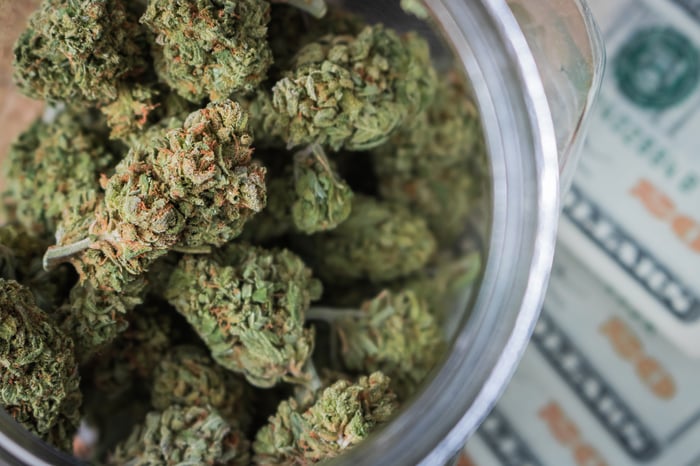Last year was a breakthrough year for the legal cannabis industry. Having long been viewed as taboo, the passage of the Cannabis Act in June in our neighbor to the north, and the official legalization and sale of recreational marijuana in licensed dispensaries and online stores as of Oct. 17, 2018, in Canada, validated the industry as a legitimate business model.
Pundits are no longer asking whether the cannabis industry can survive. Nowadays, the questions revolve around how large the global weed industry could grow over the next decade, with some on Wall Street calling for as much as $75 billion in annual sales.
However, your vision of what the existing cannabis industry looks like in Canada may not be correct.

Image source: Getty Images.
If you think you know Canada's marijuana industry, think again
Every three months, Statistics Canada releases the results of its National Cannabis Survey from the previous quarter. This survey examines current and expected use rates, as well as the most likely methods of consumption. In early February, Statistics Canada released its survey findings from the fourth quarter of 2018.
If you're like every other investor, you'd be expecting recreational marijuana sales to dominate, especially with the curtain of prohibition on adult-use sales coming to a close on Oct. 17. Interestingly, though, this isn't what the data showed. Of the respondents aged 15 and older who used cannabis in the past three months, 7% reported using weed solely for recreational purposes, 4% consumed cannabis solely for medical purposes, and another 4% used it for medical and nonmedical purposes, for a combined use rate of 15% (or 4.6 million Canadians, on an extrapolated basis). The surprise is that more than half of all users still consume marijuana, in some capacity, for medical purposes and not just for recreational use.
Not only did medical marijuana remain a big part of the Canadian pot industry during the fourth quarter, but medical weed patients were far more willing to use cannabis and open their wallets relative to recreational consumers. Just one in five nonmedical users reported using cannabis daily or almost daily, which compares to 70% of medical users with documentation (i.e., an issued medical card) and 46% of medical users without documentation. Additionally, 95% of medical users with documentation reported spending money on marijuana in the last three months, compared to just 57% of nonmedical users.
The National Cannabis Survey also found a marked difference in the way medical and nonmedical users consume the product. More than four of five (83%) recreational users preferred smoking their cannabis, whereas less than two out of five (37%) medical users felt the same. Rather, medical patients are far more likely to prefer lotions, sprays, or other alternatives, such as oils, relative to smoking.

Image source: Getty Images.
Don't forget about the medical cannabis market
If you haven't figured out the takeaway by now from Canada's quarterly cannabis survey, it's that the medical marijuana market isn't going to simply disappear because adult-use weed is now legal. In fact, it suggests that pot stocks that choose to focus on medical patients could be handsomely rewarded.
Even though the recreational marijuana market offers a much larger consumer pool than the medical market, the important figure to focus on is margins.
The survey shows that a majority of recreational users tend to buy dried cannabis flower; and that their purchases of flower tend to be inconsistent. As we've seen from the likes of Colorado, Washington, Oregon, and even California to some extent, in the United States, dried flower has a tendency to become oversupplied and commoditized over time. This pushes down the per-gram price for dried cannabis and can weigh on margins.
By comparison, medical users tend to purchase cannabis far more consistently to control their ailment(s) in question, and they prefer nonsmoking methods of consumption. Alternative products, such as oils, carry much higher price points than dried cannabis flower. In this instance, a higher price point does actually mean a higher-margin product. All things considered, medical marijuana patients offer more bang per revenue dollar to marijuana stocks than recreational consumers.

Image source: Getty Images.
These two giant pot stocks are on diverging paths
However, the two largest pot stocks by market cap are taking very different paths to how they'll approach the burgeoning cannabis market.
On one hand, Aurora Cannabis (ACB -4.85%), the projected largest producer with perhaps up to 700,000 kilos in peak annual production, is expected to focus on medical marijuana patients. Even with the company noting in its second quarter operating results that it sold roughly 20% of all weed in Canada during the fourth quarter, Aurora wound up generating more revenue from the medical side of the equation than recreational. By focusing its efforts on medical pot patients and emphasizing its alternative products, coupled with the economies of scale that should come with production expansion, Aurora Cannabis is angling for above-average operating margins among Canadian growers.
On the other hand is Canopy Growth (CGC -10.51%), the largest publicly traded marijuana stock in the world, and the second-biggest projected producer by peak annual output. Canopy Growth's latest quarterly operating results featured a company that recorded 71.6 million Canadian dollars (CA$71.6 million) in gross recreational pot sales, and just CA$18.6 million in gross medical use sales. On a year-over-year basis, gross medical marijuana revenue actually fell by CA$1.7 million in the fiscal third quarter. To be clear, Canopy's focus on the recreational marijuana market doesn't mean it won't be successful. But it does suggest, at least based on the data from the National Cannabis Survey, the company's margins won't be as robust as Aurora's.
In sum, don't count on the medical market being driven to the backburner, as once predicted.
Check out the latest earnings call transcripts for Canopy Growth and other companies we cover.





